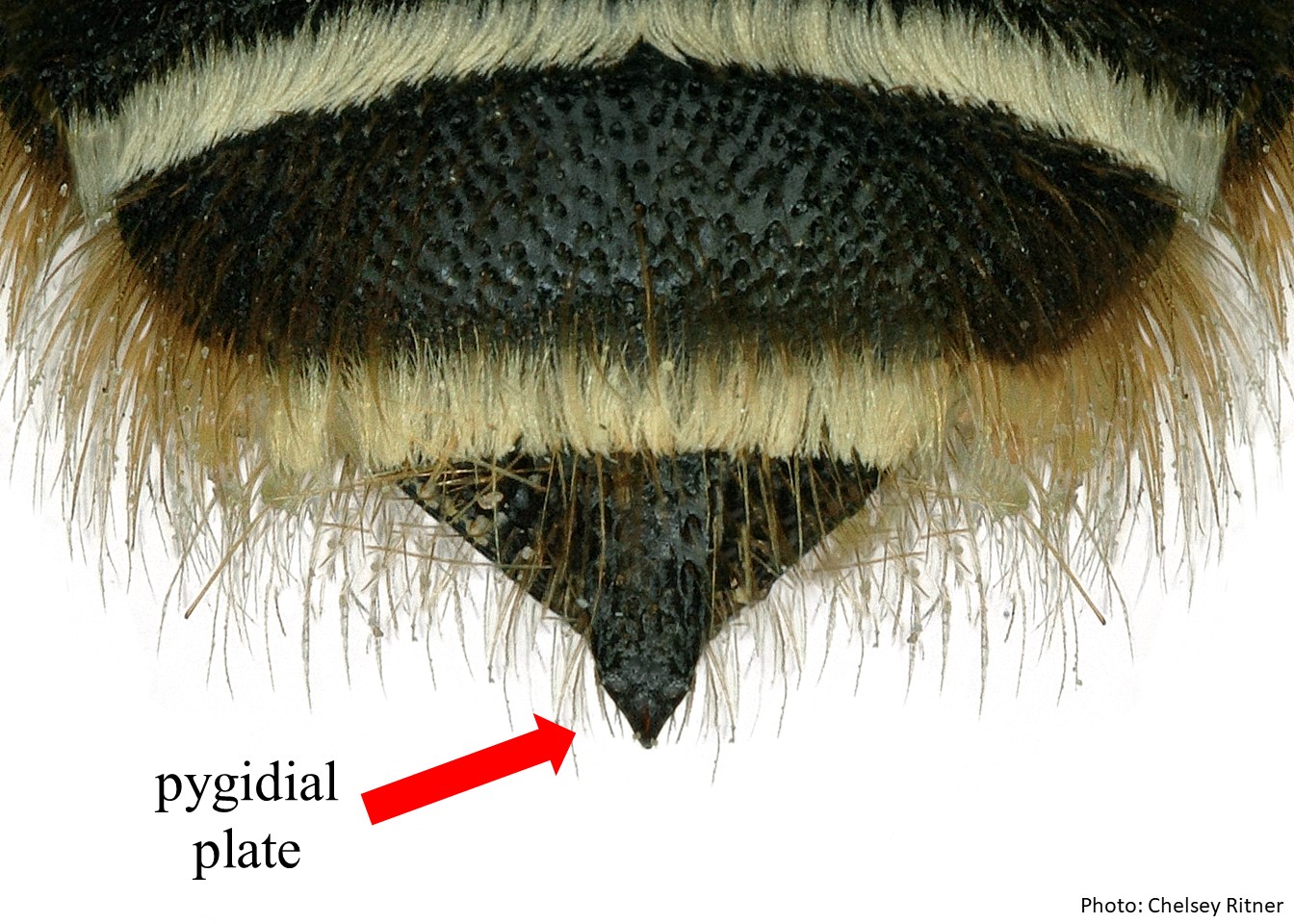Xylocopa (Nanoxylocopa) are somewhat robust, small bees, 10 – 15 mm in length, with black integumentintegument:
a tough, protective outer layer
and very weak metallic reflections in bright light. They have thick pubescencepubescence:
short, fine hair
that is mostly pale, with some dark areas in males, and primarily brown to black in females. Their wings range from amber to light amber, almost gold colored (Hurd and Moure 1963Hurd and Moure 1963:
Hurd, P.D. and J.S. Moure. 1963. A Classification of the Large Carpenter Bees (Xylocopine) (Hymenoptera: Apoidea). University of California Publications in Entomology (Vol. 29). Berkeley and Los Angeles: University of California Press, 365 pp.; Melo 2016Melo 2016:
Melo, G. A. R. 2016. A new species of Xylocopa ( Nanoxylocopa ) from Brazil (Hymenoptera, Apidae). Papeacute;is Avulsos de Zoologia 56(9): 103-107.).
Xylocopa (Nanoxylocopa) contains two species: Xylocopa ciliate and Xylocopa bellus (Melo 2016Melo 2016:
Melo, G. A. R. 2016. A new species of Xylocopa ( Nanoxylocopa ) from Brazil (Hymenoptera, Apidae). Papeacute;is Avulsos de Zoologia 56(9): 103-107.).
Xylocopa (Nanoxylocopa) can be found in Argentina, southern Brazil, Paraguay, and Uruguay (Hurd and Moure 1963Hurd and Moure 1963:
Hurd, P.D. and J.S. Moure. 1963. A Classification of the Large Carpenter Bees (Xylocopine) (Hymenoptera: Apoidea). University of California Publications in Entomology (Vol. 29). Berkeley and Los Angeles: University of California Press, 365 pp.; Melo 2016Melo 2016:
Melo, G. A. R. 2016. A new species of Xylocopa ( Nanoxylocopa ) from Brazil (Hymenoptera, Apidae). Papeacute;is Avulsos de Zoologia 56(9): 103-107.).

Distribution map generated by <a data-cke-saved-href="https://www.discoverlife.org/mp/20m?w=1200&kind=Xylocopa+ciliata" href="https://www.discoverlife.org/mp/20m?w=1200&kind=Xylocopa+abbreviata" _blank"="">Discover Life -- click on map for details, credits, and terms of use.
Xylocopa (Nanoxylocopa) are generalist pollinators and are even known to pollinate several South American crops, including passion fruit (Yamamoto et al. 2013Yamamoto et al. 2013:
Yamamoto, M., C. N. Junqueira, A. A. A. Barbosa, S. C. Augusto, and P. E. Oliveira. 2014. Estimating crop pollinator population using markndash;recapture method. Apidologie 45: 205-214.; Melo 2016Melo 2016:
Melo, G. A. R. 2016. A new species of Xylocopa ( Nanoxylocopa ) from Brazil (Hymenoptera, Apidae). Papeacute;is Avulsos de Zoologia 56(9): 103-107.). They have also been recorded visiting flowers of a number of plant families including: Asteraceae, Boraginaceae, Compositae, Convolvulaceae, Fabaceae, and Solanaceae (Hurd 1978aHurd 1978a:
Hurd, P.D. 1978a. An Annotated Catalog of the Carpenter Bees (Genus Xylocopa Latreille) of the Western Hemisphere (Hymenoptera: Anthophoridae). Smithsonian Institution Press, Washington D.C. 106 pp.).
(modified from Michener 2007Michener 2007:
Michener, C.D. 2007. The Bees of the World (2nd ed.). Johns Hopkins University Press, Baltimore and London, 953 pp.)
 with apicalapical:
with apicalapical: with subapicalsubapical:
with subapicalsubapical:X. (Nanoxylocopa) is most similar to X. (Schoenherria) and X. (Cirroxylocopa). Females can be distinguished from the other subgenera by their transverse, tuberculiformtuberculiform:
a small knob-like or rounded protuberance
frontal carinacarina:
a clearly defined ridge or keel, not necessarily high or acute; usually appears on bees as simply a raised line
. Males can be distinguished by the unmodified tegulategula:
the usually oval, small shield-like structure carried at the extreme base of the wing where it attaches to the body with punctations throughout.
Xylocopa (Nanoxylocopa) primarily makes its nests in the dead flower stalks of the genus Eryngium (Hurd and Moure 1963Hurd and Moure 1963:
Hurd, P.D. and J.S. Moure. 1963. A Classification of the Large Carpenter Bees (Xylocopine) (Hymenoptera: Apoidea). University of California Publications in Entomology (Vol. 29). Berkeley and Los Angeles: University of California Press, 365 pp.) but has also been found to make nests in Agave, Arundo donax, Escallonia, Foeniculum vulgare, and Helianthus annuus (Hurd 1978b).
There are no known invasives.
Hurd, P.D. 1978a. An Annotated Catalog of the Carpenter Bees (Genus Xylocopa Latreille) of the Western Hemisphere (Hymenoptera: Anthophoridae). Smithsonian Institution Press, Washington D.C. 106 pp.
Hurd, P.D. 1978b. Bamboo-Nesting Carpenter Bees (Genus Xylocopa Latreille) of the Subgenus Stenoxylocopa Hurd and Moure (Hymenoptera: Anthophoridae). Kansas (Central States) Entomological Society 51(4): 746-764.
Hurd, P.D. and J.S. Moure. 1963. A Classification of the Large Carpenter Bees (Xylocopine) (Hymenoptera: Apoidea). University of California Publications in Entomology (Vol. 29). Berkeley and Los Angeles: University of California Press, 365 pp.
Melo, G. A. R. 2016. A new species of Xylocopa (Nanoxylocopa) from Brazil (Hymenoptera, Apidae). Papéis Avulsos de Zoologia 56(9): 103-107.
Yamamoto, M., C. N. Junqueira, A. A. A. Barbosa, S. C. Augusto, and P. E. Oliveira. 2014. Estimating crop pollinator population using mark–recapture method. Apidologie 45: 205-214.